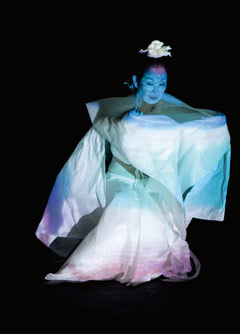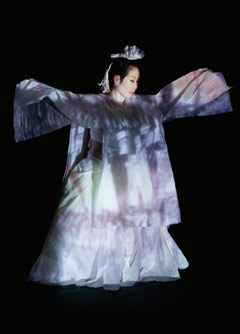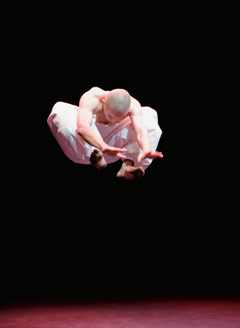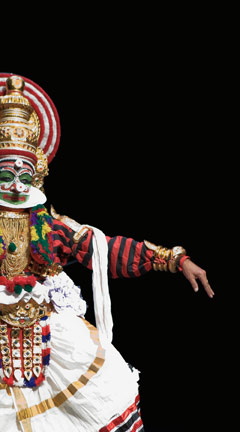There are times when yogis don’t sit, or walk, or bow, or chop wood. They dance. Nearly forty years ago, Sun Ock Lee, a Korean Zen Buddhist, dancer, and choreographer discovered that sitting meditation was out of the question for her. Nerve damage to her leg following a childhood illness made it too painful. So she began experimenting with a series of breathing techniques and refined movements that have blossomed into a repertoire of extraordinarily beautiful dances, a company, and a healing system she has come to call ZenDance.
ZenDance mingles traditional Korean forms and other Asian idioms such as Cambodian, Tibetan, and Nepali dance, Buddhist mudras, and video installation, often using rice paper costumes and sets that evoke Korean folk customs as well as dharmic ideas of transience and transformation. For Lee, the genesis of ZenDance is tanjeon breathing: cultivating a meditative breath from the lower abdomen. “Zen dancing does not come from improvisation,” says Lee. “It is born within the body in a state of meditation. Each dancer bears her own dance; she must have the strength to seek it out and then to accept it. Then everything becomes simple.”
This winter in New York City, Lee orchestrated a festival of meditative dance forms from the Asia-Pacific region whose practioners met to perform and discuss the therapeutic and contemplative aspects of their work. Her company’s contribution, a piece called “Form Is Emptiness” in homage to the Heart Sutra, featured sonmudo, a Korean Zen martial art , in concert with the slow, ethereal gestures of ZenDance. Other performances included the genre called Kudiyattam, an Indian dance theater believed to be the oldest living theatrical form in the world.
Kudiyattam, from the Kerala region of India, tells stories from the Hindu canon, but the fundamentals of meditation, mudra, and abhinaya—expression, or transmission, directed toward the audience—are precursors to those in ZenDance and other, more traditional dances such as Japanese Noh. The subtlety of Kudiyattam is mindblowing: in the New York festival, a dancer playing the demon king Ramana portrayed his state of mind after a battle for the heavens, the earth, and the underworld, often with no movement more gross than the cant of an eyebrow or the pivot of an index finger. Such dance, says Lee, moves “beyond religion; it manifests all of reality. It is an embodiment of meditation in motion.”
Dancers performing in ZenDance’s “Form Is Emptiness,” a Korean Zen martial art piece featured in the Asian Pacific Performing Art Network’s New York City festival this past winter. “Each dancer bears her own dance,” says Sun Ock Lee (above), the dancer and choreographer who orchestrated the festival. “She must have the strength to seek it out and then to accept it. Then everything becomes simple.”



Thank you for subscribing to Tricycle! As a nonprofit, we depend on readers like you to keep Buddhist teachings and practices widely available.
